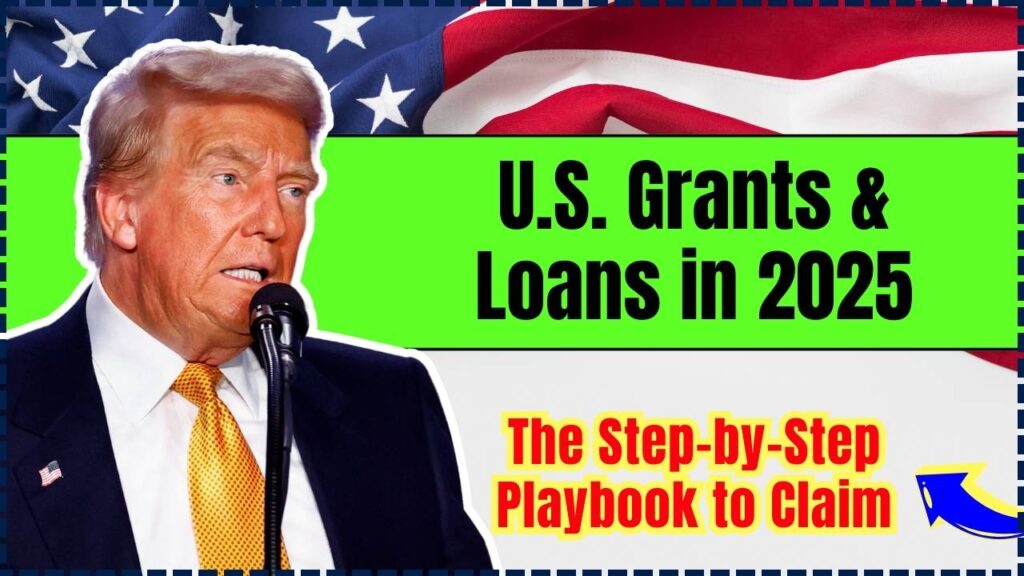U.S. Grants & Loans in 2025: Navigating U.S. grants and loans in 2025 might feel like venturing through a maze, especially with evolving eligibility criteria, new application technologies, and an overwhelming number of programs targeting different needs. But whether you’re a student facing college tuition, a single mom trying to launch a business, a retiree renovating your rural home, or a disaster survivor in urgent need of relief, help is available—and claiming it could be easier than you think.

This updated, in-depth guide will walk you through every major federal grant and loan program available in 2025. With real-world success stories, resource links, pro tips, and a clear checklist-style approach, you’ll learn not just what to apply for—but how and when to do it.
U.S. Grants & Loans in 2025
| Category | Details |
|---|---|
| Education Grants | Pell Grants up to $7,395; apply via FAFSA |
| Student Loans | Subsidized and Unsubsidized Direct Loans; apply via FAFSA; repayment starts post-school with flexible plans |
| Small Business Loans | SBA 7(a), Microloans, Disaster Assistance Loans; access via SBA.gov |
| Housing Assistance | USDA Section 504 Loans and Grants for rural residents; apply via USDA.gov |
| Disaster Relief | FEMA Individual and Public Assistance Grants; fast-track help for natural disaster recovery; apply at FEMA.gov |
| Veteran Support | VA-backed loans, grants for disabled veterans, and small business help; visit VA.gov |
| Resource Hub | Grants.gov, USAGov, StudentAid.gov |
In 2025, the federal government is distributing billions in grants and low-interest loans. But too many Americans don’t apply—not because they’re ineligible, but because they don’t know where to start. This guide is your launchpad.
Whether you’re 18 and heading to college, 45 and reinventing your career, or 70 and securing housing—you have options. All it takes is knowing the rules, preparing your documents, and clicking apply.
What Are Federal Grants and Loans and Why Do They Matter?
Federal Grants
Federal grants are essentially financial gifts from the government. These funds are non-repayable, meaning you don’t have to pay them back. They exist to support key needs:
- Making college affordable
- Supporting families hit by economic hardship
- Helping underserved communities improve infrastructure and housing
- Assisting in disaster recovery efforts
Popular federal grants in 2025 include:
- Pell Grants (education)
- Supplemental Educational Opportunity Grants (SEOG)
- Section 504 Housing Grants
- FEMA Assistance Grants
Federal Loans
Federal loans are borrowed funds you do have to repay—but with lower interest, flexible repayment plans, and borrower protections not found in private loans. These loans fuel:
- Higher education
- New and growing small businesses
- Housing and home improvements
- Recovery and rebuilding post-disaster
Federal loans are popular due to their favorable terms and government backing. Think of them as your safety-net option that empowers economic mobility.
The Ultimate U.S. Grants & Loans in 2025 Guide to Applying in 2025
- Know What You’re Eligible For: Every program has specific requirements, often based on:
- Household income
- Family size
- Geographic location
- Purpose of use (school, home, business, etc.)
- Citizenship or legal resident status
- Use these tools to assess eligibility:
- Grants.gov Eligibility Quiz
- Benefits.gov Eligibility Finder
- Choose the Right Program for You: Once you know your goal, head to the corresponding portal:
- College/Student Aid: StudentAid.gov
- Small Businesses: SBA.gov
- Housing: USDA Rural Development
- Veteran Support: VA.gov
- Disaster Help: DisasterAssistance.gov
- Each portal lists programs, instructions, and updates to deadlines or qualifications.
- Get Your Documents in Order: You’ll likely need:
- Proof of income (W-2s, pay stubs, recent tax returns)
- Identity (ID, SSN, residency status)
- Purpose-specific docs (school enrollment, business plan, home deed, etc.)
- Banking info for direct deposit
Pro Tip: Create a “Grant & Loan Folder” on your device to upload all required files in one place.
- Apply Online at Official Portals: Almost every major federal program has moved online in 2025. Use only secure, official .gov websites.
- FAFSA: studentaid.gov
- SBA Loans: lender match
- USDA Home Loans: rd.usda.gov
- FEMA Grants: disasterassistance.gov
- Most platforms include tracking dashboards to check the status post-submission.
- Monitor and Follow Up: After submitting:
- Check your email for requests or approvals
- Track the status via program dashboard (e.g., FAFSA updates through your account)
- Contact hotlines if there’s a long delay
Real-World Stories: How People Are Winning in 2025
Avery, a Low-Income Freshman
Avery used the FAFSA to qualify for a $7,200 Pell Grant and a $3,500 subsidized loan, covering tuition and supplies. He avoided private debt completely.
Samira, a First-Time Business Owner
Samira applied through SBA Lender Match and received a $50,000 microloan to open her food truck. She also accessed free business coaching and digital marketing workshops.
Marcus, a Hurricane Victim
After flooding destroyed his home, Marcus applied through DisasterAssistance.gov and received $28,000 in FEMA funds to repair and replace vital belongings.
John, a Disabled Veteran
John secured a VA Special Housing Adaptation Grant worth $20,000 to retrofit his home for wheelchair access. He also used a VA loan to refinance his mortgage.
Expert Tips to Increase Approval Odds
- Apply early: Funding is often first-come, first-served.
- Double-check every field: One mistake can delay or deny your application.
- Use auto-fill tools with caution: They can misread form fields.
- Seek free help: Local community centers, financial aid offices, and SBA development centers offer assistance.
- Beware of scams: Never pay someone to “get you approved.”
FAQs On U.S. Grants & Loans in 2025
Can I apply for more than one grant or loan?
Yes, many recipients stack programs—like Pell Grants plus USDA loans. Just ensure eligibility doesn’t overlap unfairly.
Do I need a cosigner for federal loans?
Usually not. Federal student loans and many USDA loans do not require cosigners.
What happens if I’m denied?
You can reapply or appeal. In some cases, better documentation or a corrected form leads to approval.
Can non-citizens apply?
Some programs allow green card holders and certain visa statuses. Check eligibility pages for specific rules.
How long does it take to receive funds?
It depends:
- FAFSA: 3–7 business days post-approval
- SBA: 4–12 weeks
- FEMA: As fast as 7–14 days for emergencies
- USDA: 30–60 days






